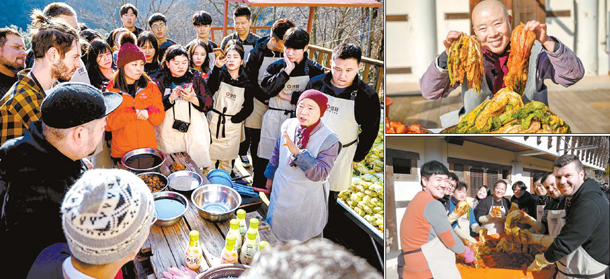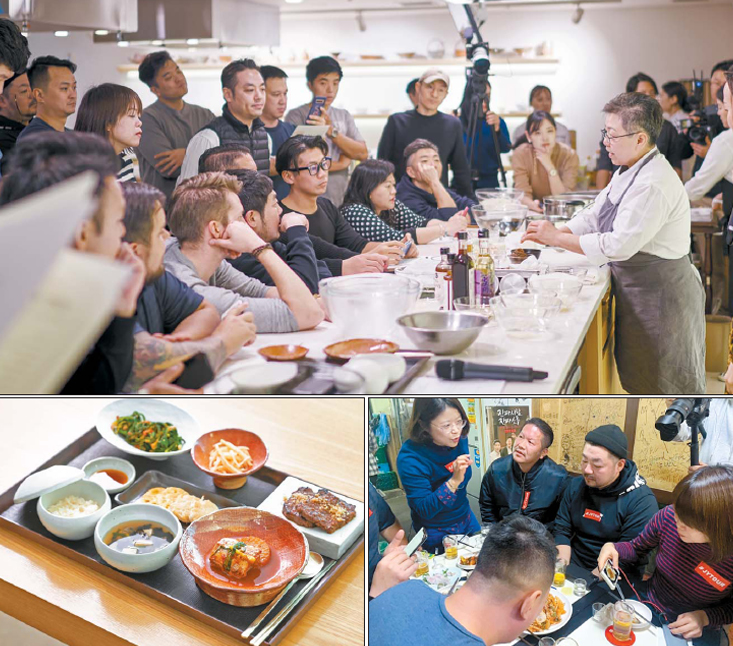Learning the magic behind Korea’s banchan: Chefs from across Asia pick up tips on making tasty kimchi and more

Chefs from Japan, Hong Kong, Thailand and more gather at Baekyang Temple in South Jeolla on Saturday to try making kimchi with Jeongkwan Sunim, a Buddhist monk who became internationally known through an episode of “Chef’s Table” on Netflix. [KIM HYE-JOON, JANG EUN-SIL, SEMPIO]
Chefs who run restaurants in Taiwan, Japan, Hong Kong and more came to Korea last week to see what the hype over Korean food is all about and to get hands-on experiences on making dishes that they have only seen at food festivals and on TV shows.
While many of the chefs were familiar with the uniqueness of Korean-style temple cuisine and the Korean fermentation process often referred to as “jang” culture, many of them had not actually made a trip out to Korea to experience Korean food firsthand.
Besides making kimchi, the chefs got to know more about how Korean staple foods are served in a set that includes a bowl of rice and soup accompanied by banchan, which are assorted dishes of vegetables, meat and seafood and is commonly translated as side dishes.
The event is an annual program put on by Korean food company Sempio along with Buddhist monk Jeongkwan so that visiting chefs get the chance to learn a little bit more about Korean food while interacting with local chefs here and discovering restaurants in Korea. This year, Richie Lin of Mume in Taipei, Jimmy Lim of JL Studio in Taichung, Taiwan, Vicky Cheng of Vea in Hong Kong, Agutin Balbi of restaurant Haku in Hong Kong, Thitid Tassanakajohn, more commonly known as Chef Ton, of Le Du in Bangkok, Yusuke Namai of Restaurant Ode in Tokyo, Yusuke Takada of La Cime in Osaka, Japan, Takeshi Fukuyama of La Maison de La Nature Goh in Fukuoka, Japan and Miles Pundsack-Poe of Ensue in Shenzhen, China, were some of the chefs who visited.
In addition to making kimchi, the chefs were brought to a cooking class sponsored by the Korean Food Promotion Institute and Tasty Production and also visited local hotspots during an event called “Banchan Road.”
They were put into different groups to visit many well-known fine dining places such as Mosu in central Seoul, Mingles and Gaon in southern Seoul. They also tried a variety of casual bars and restaurants like Golden Pig Restaurant, known in Korean as Geumdwaeji Sikdang.

Top: Chef Cho Hee-sook presents a cooking class at the Korean Food Promotion Institute in central Seoul to better introduce Korean food staples. Above left, a sample set of rice, soup and banchan, or side dishes, made during a cooking class. Abover right, chefs visit restaurants to try out different types of banchan at so-called nopo, or restaurants that have been running for decades, in central Seoul. [TASTY COOK BOOK, JANG EUN-SIL]
Some of the visiting chefs had already collaborated with local chefs, such as Jimmy Lim and chef Kim Dae-chun of Seventh Door, and many of the others took their time in Korea as an opportunity to seal the deal for future collaborations.
Prior to the kimchi-making session on Saturday at Baekyang Temple in South Jeolla, where Jeongkwan Sunim - who appeared on the popular Netflix program “Chef’s Table” - lives and works, the visiting and Korean chefs gathered to participate in a cooking class by veteran chef Cho Hee-sook.
The chef, who is known in Korea as the chef’s teacher because of the series of cooking classes she offers in which she shares her traditional recipes that are not widely prepared at local restaurants, demonstrated how to make very basic banchan to show the foods that Koreans eat on daily basis.
“When there is a sturdy base, other things that come after happen without too much effort,” Cho said during her cooking demonstration at the Korean Food Promotion Institute in central Seoul, explaining that the Korean tabletop all starts from thinking of what would pair well with a bowl of rice.
“What Koreans eat all started from finding the balance through food, so besides the staples of rice and soup, we add different banchan, at least one vegetable, one meat and one seafood dish.”
The winter is the time to make the best use of root vegetables, chef Cho said, while making lotus root jeon, often referred to as a pancake. Pieces of lotus root are cut into thin slices, and then pan-fried along with flour and egg. She also ground some roots and mixed it with long strips to pan fry the dough.
Another specialty she suggested eating was spinach. Marinated lightly either with gochujang (hot pepper paste), doenjang (fermented soy bean paste) or ganjang (soy sauce), the chef said that winter spinach is sweeter than during any other time of year.
One of the most eye-catching dishes prepared during Friday’s class was galchi jorim, or braised beltfish. Many questioned whether the meat of the fish gets smashed after being boiled on top of sliced radish in water. They were interested how kelp broth is made to cook beltfish in, especially the Japanese chefs, who use broth made with kelp often in their food.
Banchan is not something that is served in addition to the main dish, but the collection of banchan itself is a dish for an everyday Korean meal. Though banchan is usually served in small dishes, they are refillable, and now food experts in Korea are trying to come up with a better way to translate the word so that people around the world can have a better understanding of the concept.
In South Jeolla, the chefs learned that Korean-style temple food refrains from using five ingredients that have strong scents, including chives, garlic and scallions, which is the reason why kimchi made at temples tends to be milder. Temples also doesn’t use salted fish at all, one of the key items that decides different flavors of kimchi from house to house. The monk suggested alternatives for international chefs who may want to make their own kimchi at home, such as red bell peppers and tomatoes, as well as food additives from Korean food companies.
“Not everyone living overseas has access to five-year old soy sauce or other condiments that make the unique flavor of each household’s kimchi,” said Jeongkwan Sunim, “so it might be helpful to find your own condiments to provide deeper flavors to the food that you cook.”
Chefs tried making two versions, one with the condiment yondu and one without, so that they can see what elements make a difference in the final product.
“The fact that it is a team effort was something really impressive,” said chef Vicky Cheng of Hong Kong, with all the chefs gathered together to mix the cabbage with the marinade for hours.
“It is informative to see that there are many elements to making banchan, and I see lots of similarities in the cuisines [my parents] grew up with in China.”
After making their own banchan, the chefs continued on their journey to visit nopo, or restaurants that have been running for decades across Korea, to see what banchan was available at each, so that they could understand the varieties of styles developed by each household, rather than the set recipes coming from books.
“What’s so common for Koreans can still be something really fun for foreigners,” said Jang Eun-sil, editor in chief of Tasty Cook Book, who is in the process of starting a production company of the same name. This was her first project to see whether the content would be welcomed by people overseas.
“Since Korean food is something that’s widely talked about among culinary experts at the same time, we will continue to give more details about basic things and add something interesting so that chefs can pick up ideas that could make it into their cooking later on.”
BY LEE SUN-MIN [summerlee@joongang.co.kr]










with the Korea JoongAng Daily
To write comments, please log in to one of the accounts.
Standards Board Policy (0/250자)